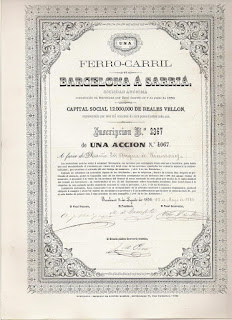There are 3 reasons why this share certificate of the Ferro-Carril de Barcelona á Sarriá railway company is so appealing to collectors.
 |
| una acción de 100 Pesos Fuertes 1859, reissued 22th May 1866 printed by Imprenta de Narciso Ramirez in Barcelona |
Early Spanish railroad
First of all, this is an early railway share for Spain, 150 years old. Railways appeared rather late in a politically instable and less economically developed Spain. The first line in Spain, opened in 1848, was a short line from Barcelona to Mataró. In the 1850s, after new laws were passed, foreign capital found its way to railway investment. In these times, Spanish railways had to be built on an unusual broad track gauge making the network incompatible with that of France and therefore hindering any French invasion. The Ferrocarril de Barcelona a Sarrià was formed in 1859. With an initial track of 4,75 km, connecting Barcelona with the communities of Gràcia, Sant Gervasi and Sarrià, the company was succesful. Some of the remarkable shareholders were the Duque of Rianzares and the playwright and diplomat Juan de Grimaldi. Due to financial difficulties , the company was absorbed in 1874 by a new company called Ferrocarrill de Sarrià a Barcelona.
Scarce
Second reason, it is scarce. Though many years of research by specialised collectors preceeded the publishing date of the Boone-Shakespeare catalogue on Spanish and Portuguese railway companies (see here ), this certificate is not listed in it. The following certificates were recorded in the catalogue for the Ferro-Carril de Barcelona á Sarriá company :
- Cat. 2420A : Accion of 100 Pesos fuertes, 1859, capital 12.000.000 Reales Vellon
- Cat. 2420B : 5 Acciones, 1859, same capital
- Cat. 2420C : Obligacion (authorised issues from 1864)
The certificate shown here is an Acción of 100 Pesos fuertos, issued in 1866 with the manually corrected date 22th May 1866.
Duque de Rianzares (Riansares)
The share is issued to the Duke of Rianzares , who had fallen in love with the queen of Spain. This is the third reason why this is an interesting share certificate.
This share is issued to Augustín Fernández Muñoz, Duke of Rianzares, 2nd husband of Maria Christina of Bourbon-Two Sicilies, queen and regent of Spain. Maria Cristina was married to Ferdinand VII of Spain. Their eldest of 2 daughters was Isabella (the future Queen Isabella). Muñoz was a member of the Royal Bodyguard of Madrid and somehow attracted the attention of the queen. After the death of her husband on 29 Sep 1833, the queen became regent of Spain and she married Muñoz secretly. A year later, their first daughter Maria Amparo, Countess of Vista Alegre, was born. Several children would follow. When the marriage became publicly known, it was not accepted by a large part of the public and the political elite.
 |
María Cristina de las Dos Sicilias 1806-1878 |
The early railway Compañia de Caminos de Hierro de la Reina Cristina, formed in 1831, was named after her, and so was the Compañia de los Caminos de Hierro de Maria Cristina in 1844. Both companies would not built a line.
In 1840, political troubles – the Carlist Wars - made the queen and Muñoz leave the country but she could save the throne for her daughter. In 1843, Muñoz and the queen could return to Spain. One year later, his step-daughter Queen Isabella II, by then declared to be of age, consented to her mother's marriage, which was publicly performed. Muñoz was created Duke of Rianzares and was made a Knight of the Golden Fleece. It was said that he made his fortune out of railway concessions and stock exchange speculations. Further political struggles would force the queen to leave Spain permanently.
 |
| Augustín Fernández Muñoz Duke of Rianzares 1808 - 1873 |
F.L.
Further references :
- Reference catalogue of Bonds & Shares on Railway & Tramway companies in Spain & Portugal
- Queen Maria Cristina and Friends, by H. Shakespeare, published in the I.B.S.S. Journal, Feb 1996
- The Story of the Duke of Rianzares, online article from the New York Times, Sep 23 1873


In first place, I expose my congratulations for the quality of your blog and especially for this article about the company of the "Ferrocarril de Barcelona a Sarrià".
ReplyDeleteIn fact the history of this company is very interesting, first because was acquired by the belgian company "Societe Generale de Tramways Electriques en Espagne" and after by the "Les Tramways de Barcelona" controlled by the german company AEG.
Sometime after, concretely The 17th of june 1911 the "Ferrocarril de Barcelona a Sarrià" was acquired by Dr. Frank Pearson and was become a company of the "Barcelona Traction Light and Power" group and changing their name to "Ferrocarriles de Catalunya S.A." (F.C.C.). In this period the company expanded the line and initiated the perforation a tunnel under the Tididabo mountain who allowed connect Barcelona with the Vallès area by train.
Actually the company still exists as a public company of the regional government of Catalonia and is the most used public railroad network in Catalonia.
Hola Anonymous, muchas gracias.
ReplyDeleteThis is indeed interesting information about this railway, new to me. Thank you for sharing!
Franky